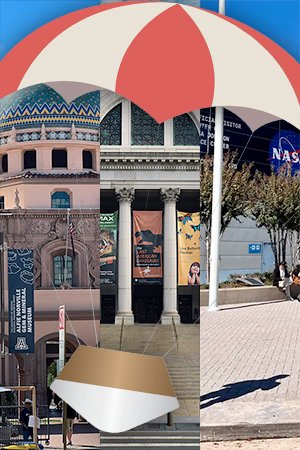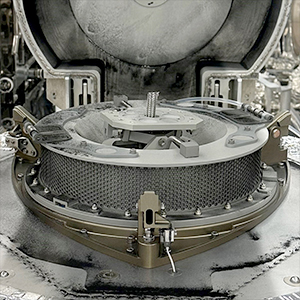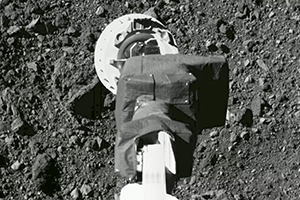September 27, 2023 — As NASA saw its first asteroid sample return to Earth this past weekend, three museums took particular notice knowing that they had been chosen to display small examples of the newly-landed space rock material.
The Smithsonian's National Museum of Natural History in Washington, D.C., Space Center Houston in Texas and the University of Arizona's Alfie Norville Gem and Mineral Museum in Tucson were quietly selected by NASA to exhibit a piece of the asteroid Bennu as brought back to Earth by the space agency's OSIRIS-REx mission. The probe's sample return capsule touched down in the Utah desert on Sunday morning (Sept. 24).
collectSPACE first learned of the chosen locations from sources with knowledge of NASA's plans. The museums then confirmed the details in separate statements.
"The Smithsonian National Museum of Natural History expects to receive two samples from the asteroid Bennu this fall," said Ryan Lavery, senior press officer with the museum. "The first will serve as a cornerstone of the museum's 'Our Unique Planet' research initiative which seeks to answer fundamental questions about the origins of life, the ocean and the continents on Earth."
"The second will go on exhibit in our Hall of Geology, Gems and Minerals. It will be the first sample of Bennu put on public display in the United States and we look forward to sharing it with our more than four million annual visitors," Lavery said. "We will announce the unveiling date in the near future."
A spokesperson for the Alfie Norville Gem and Mineral Museum told collectSPACE that a sample is expected to go on display in November and more details would be shared when available.
"As we prepare for the arrival of the OSIRIS-REx sample here at Space Center Houston, we are celebrating a scientific triumph by sharing a piece of the cosmos that reminds us of humanity's boundless curiosity and our relentless quest to unlock the mysteries of the universe," said William Harris, president and chief executive of Space Center Houston, the official visitor center for NASA's Johnson Space Center and a Smithsonian affiliate. "This celestial treasure embodies the spirit of exploration, and its presence here inspires us all to continue pushing the boundaries of human knowledge and space exploration."
While the details of the displays are still being worked out, including the size and nature of the material they will contain, the venues have been told to be ready as early as mid-November for the possible delivery of their Bennu specimen. First, though, scientists need to inspect, categorize and begin studying the contents of the OSIRIS-REx capsule.
Fortunately, there are indications that the spacecraft landed on Earth with more material than the mission was targeted to return. According to NASA, the capsule is estimated to be holding about a half a pound of rocks and soil, or about 8.8 ounces (250 grams).
"We promised the agency we would bring back two ounces or about 60 grams of material," Dante Lauretta, principal investigator for the OSIRIS-REx (or Origins, Spectral Interpretation, Resource Identification and Security-Regolith Explorer) mission at the University of Arizona, Tucson, said at a press briefing. "We believe, based on some very clever spacecraft engineering from our partners at Lockheed Martin — measuring the momentum change on the spacecraft as we articulated its robotic arm — that we have at least four times that material."
NASA scientists on Tuesday found black dust and debris on the avionics deck of the OSIRIS-REx science canister, hinting at the material held within.
Most of that is intended for scientific study. From the specially-built curation lab at NASA's Johnson Space Center in Houston, the plan is to distribute portions of asteroid Bennu to a sample analysis team of more than 200 members from more than 35 globally distributed institutions. Approximately six months after the return, a sample catalog will be released, and more of the material from Bennu will be made available for research by scientists around the world for decades to come.
Of the total amount received, four percent will be delivered to the Canadian Space Agency, which contributed the OSIRIS-REx laser altimeter instrument aboard the spacecraft and which supports the Canadian co-investigators on the OSIRIS-REx science team.
An addition half of a percent (0.5) of the total returned material will be provided to the Japan Aerospace Exploration Agency (JAXA) as part of a partnership between the two space agencies, which included NASA's support for JAXA's Hayabusa2 mission and the exchange of scientists and samples between the two missions.
Japan was the first to collect asteroid samples and return them to Earth with its Hayabusa and Hayabusa 2 missions in 2010 and 2020, respectively.
The material retained by NASA will be held at the Johnson Space Center, though a portion will be stored at a secure backup facility in White Sands, New Mexico, similar to the procedures that were followed to protect the Apollo moon rocks from natural disasters and attacks.
NASA placed the first Apollo moon rocks to go on display at the Smithsonian's Arts and Industries Building in Washington, D.C. on Sept. 17, 1969, and the American Museum of Natural History in New York City two months later on Nov. 16. Both exhibits drew long lines of spectators with the latter recording a record crowd of 42,195 people in the four hours the display was open on its first day.
The six Apollo moon landing missions bought back a total of 842 pounds (382 kilograms) of material, much more than OSIRIS-REx is returning, so more exhibits were possible. Today, 135 nations, the 50 U.S. states and U.S. provinces each own gifted samples from the Apollo 11 and Apollo 17 missions. NASA has also loaned more than 80 moon rocks and lunar dust samples to museums in 23 U.S. states and 11 foreign nations.
OSIRIS-REx is the third U.S. interplanetary mission to land collected material on Earth. The first, Stardust, brought back samples from Comet Wild 2 and of the interstellar dust. NASA then launched Genesis to bring back a sample of solar wind particles. A parachute failure, though, resulted in its sample return capsule to slam into the Utah desert.
The material collected by Stardust and what could be recovered from Genesis is curated at the Johnson Space Center. The empty Stardust sample return capsule, though, was transferred for display to the Smithsonian's National Air and Space Museum in Washington, D.C. in 2008. |
|

Small samples of the asteroid material returned to Earth by NASA's OSIRIS-REx mission will be publicly displayed at three museums in the United States. (UofA/Smithsonian/SCH/NASA/collectSPACE)

Black dust and debris is seen on the avionics deck of the OSIRIS-REx science canister from when its initial lid was opened. (NASA)

The OSIRIS-REx Touch-And-Go Sample Acquisition Mechanism as seen just before making contact with asteroid Bennu. (NASA)

A crowd of visitors look at the Apollo 11 moon rock on exhibit in the Smithsonian Arts and Industries Building in 1969. (Smithsonian) |
